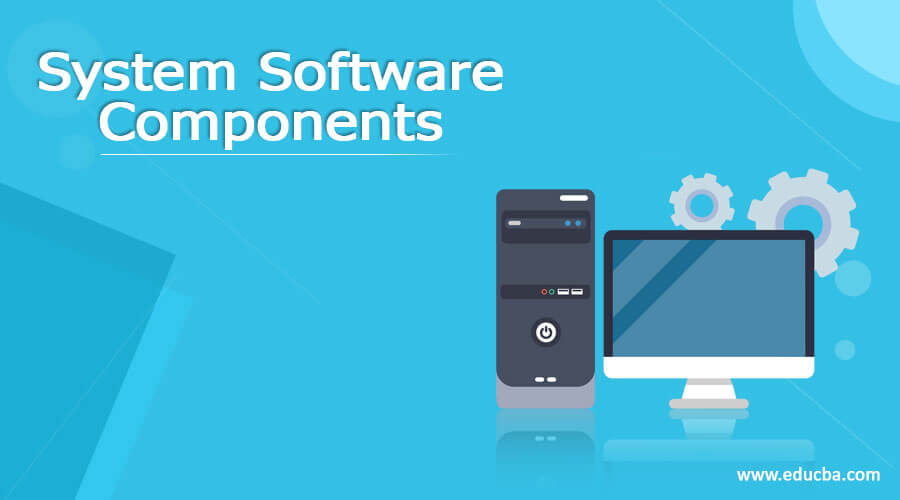Updated May 18, 2023
Introduction to System Software Components
System software components are defined as the software system designed to operate the computer’s hardware; it provides a platform to run the application software and the basic functions for computer usage. It protects the application programmer from the complexity and specific details of a particular computer being used, especially the memory and the hardware features. The component of the software is a self-contained system with one or more inputs and outputs channels; it has nothing to do with the input and does not serve anything without the output.
System software components
Let us discuss System Software Components.
-
Device Driver
This system program controls the number of devices attached o the computer; it acts as a translator between the user’s and the hardware device’s applications. A device driver tells the operating system how the device will work on certain commands the user generates. With the device’s help, driver computer hardware can interact with high-level system programs. For example, Wi-Fi driver, Bluetooth driver, etc.
-
Operating System
The operating system is the system which is the main part of the computer system, which manages the hardware of the computer consisting of programs and data. The operating system has provided the services so that we can execute the application software. The system program that makes it possible for people to interact with computers is known as the operating system. It helps other programs to run and control them.
Examples of computer operating systems are Linux, Microsoft Windows, OS X, and UNIX.
-
Server
It is a program; it works like a socket listener in a computer operating system. A server is a series of computers connected to other computers. Private and public users in a network access the internet, and the server provides that essential service.
-
Utility Software
It is used to manage hardware and application software and also performs small tasks. For example, system utilities and virus scanners, etc.
-
Windowing System
This graphical user interface component supports the window manager’s implementation, provides pointing devices like keyboards and mice, and supports graphics hardware.
-
Application programs
This is the top software layer; using it, we can perform tasks such as writing using a word processor spreadsheets for accounting; it has two supporting layers: a device driver and an operating system.
-
Root-user processes
These are programs that users with root authority can run. Through all processes, root authority is given to the administrator.
-
Assembler
An assembler, generally used in an assembly language program, is a program that converts the assembly language into machine code. The compiler operates on basic commands and code, converting them into binary code.
-
Compiler
The compiler converts the high-level programming language into the machine language. For example, in C or C++ language, we should implement a particular source code in user-understandable format printf, scanf, cout, such type of statements will generate in the user language. Hence, the compiler converts the source code into the machine language format; machine language code means a target code, so we use a compiler for conversion purposes.
-
Interpreter
The interpreter is also used to convert the source code into the target code, but the interpreter checks one instruction at a time, which means it checks line-by-line code; it checks the first line, then converts it into the target code, again checks the other programming line, and then convert into the target code.
-
Editor
The editor is the system program used to edit the text in the file. For example, we are all familiar with the Microsoft Word processor, an editor whose main tasks are editing, traversing, viewing, and displaying the text. Editor means editing the particular text or file per the user’s requirement. In addition, it links extra files and extra library files. The type of editors is Line Editor, Screen Editor, Word Processor, and Structure Editor.
-
Loader
The loader loads the complete program into the memory. When we save a particular program at that time, the program will be stored in the secondary memory. Still, when we compile and execute a specific program, the program will be executed into the primary memory. Hence, the loader converts the program’s secondary memory to primary memory. It loads a particular program into the secondary to primary memory.
-
Linker
This program links the user’s program to another program or library. It connects two or more modules into the memory and prepares for execution. It integrates the necessary functions required by the program. Some programming files use import functions in different libraries; for example, if we want to use the square-root function in our code, we must import ‘math. We include the ‘H’ library in our programming, and the linker generates the concept of linking these libraries with our programming file.
-
Debugger
A debugger is a computer program that finds errors, also called bugs, in source code. It provides the facility to halt at any point and check the changes made in the program.
-
Macro
A macro processor can replace this group of instructions when called. We use it for faster execution and reusable code, and it’s also applicable in assembling language programs.
Conclusion
In this article, we conclude that there are three essential components in a software system, the application software, the device driver, and the operating system; these three work together to perform practical tasks, and it has some translator as they are also components of the software system and they serve completely different types of jobs.
Recommended Articles
This is a guide to System Software Components. Here we discuss the Introduction and list of System Software Components, respectively. You may also have a look at the following articles to learn more –



